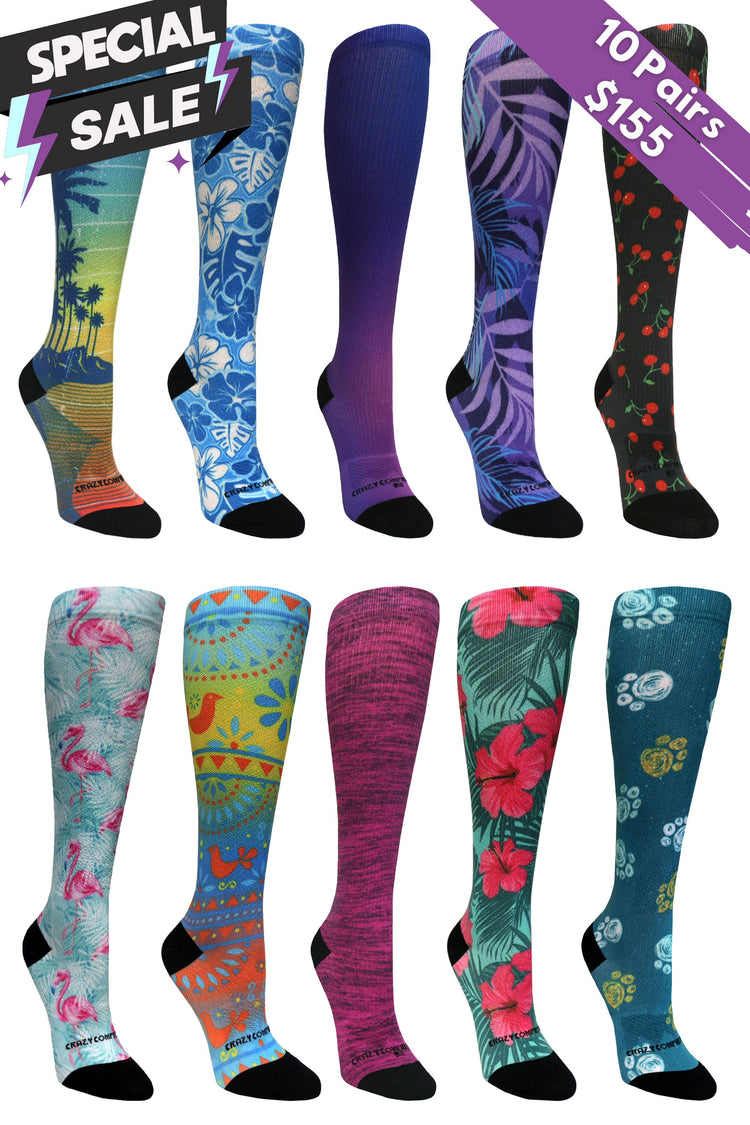Doctors often recommend compression socks to patients who suffer from swelling in their legs, venous hypertension, orthostatic hypotension, and so much more. While people with certain medical conditions should avoid wearing compression socks, there are also plenty of conditions that compression socks can help but that don’t get talked about a lot. One of these conditions is called Plantar Fasciitis.
Plantar Fasciitis causes pain in the heel of the foot, due to inflammation of the tissue that runs across the bottom of the foot, connecting the heel bone to the toe bones. People who suffer from this condition usually report feeling sharp pains in their heels when they stand after long periods of sitting or sleeping.
The causes of Plantar Fasciitis aren’t clear, but it seems more common in runners and overweight people than anyone else. Even though those who report having it also report that getting up and walking helps the pain go away, stress and tension on the foot would likely make Plantar Fasciitis worse.
To treat Plantar Fasciitis, doctors may recommend pain medication, physical therapies, or surgery if the case is severe. But there are also things you can do at home to ease the symptoms of Plantar Fasciitis, like applying ice, wearing supportive shoes, stretching your arches, and wearing compression socks.
How can compression socks help Plantar Fasciitis?
Compression socks are designed to increase blood flow from your legs to your heart. Better blood circulation helps relieve pain and reduce soreness, which takes care of many of the symptoms associated with Plantar Fasciitis. Compression socks may not heal the condition, but they can certainly relieve the most disruptive symptoms, especially while the wearer is resting instead of moving around.
Certain compression socks provide compression around the arch of the foot, and these socks may be the most helpful for patients suffering from Plantar Fasciitis since the aching tissue is in the bottom of the foot. Regular compression socks, which are tightest around the ankle and gradually grow less tight as they move up the leg, are designed for runners, athletes, nurses, and people who sit all day. They can help most leg injuries recover quickly because of the way they increase blood flow, but Plantar Fasciitis is a localized condition on the bottom of the foot, where the compression doesn’t reach.
Like we mentioned above, patients who suffer from Plantar Fasciitis experience the most pain when they stand after long periods of being off their feet. Logically, that means the single most painful part of their day is when they first get up after being asleep all night. To get the most relief from pain caused by Plantar Fasciitis, then, the patient should try wearing compression socks while they sleep and while they’re first getting up and moving around. Of course, not everyone should wear compression socks while they sleep, so if you suffer from Plantar Fasciitis, make sure you talk to your doctor before trying compression socks for yourself.
Compression socks can also be worn during exercise or while you’re sitting at your desk for long periods. Exercise usually exacerbates the pain of Plantar Fasciitis, so wearing compression socks while you walk, run, or do anything else on your feet can help relieve the tenderness you feel in the arch of your foot.
Sitting for hours on end can cause swelling in your legs and feet even if you don’t have Plantar Fasciitis; when you do suffer from the condition and have to manage additional inflammation in your feet, though, you want to avoid all the extra swelling you can. Wearing compression socks prevents fluid from building up in your lower extremities. After all, standing after sitting for a few hours will already be difficult and painful enough without the extra aches!
If you suffer from Plantar Fasciitis, there isn’t a bad time to wear compression socks, especially if you’re trying to find relief from pain! We don’t recommend wearing them 24 hours a day 7 days a week, though. If you notice any numbness or discoloration, take the socks off, give your legs a break, and talk to your doctor before trying to wear them again.
Who shouldn’t wear compression socks?
The majority of people can benefit from wearing compression socks even if they don’t suffer from a condition like Plantar Fasciitis, but there are a few medical conditions that cause compression socks to be dangerous. Some of these conditions include diabetes, peripheral vascular disease, and any other condition that could cause poor blood circulation. While it’s true that compression socks generally improve blood circulation, they do so by squeezing the veins in your legs, so if you have any kind of venous insufficiency, you could consult your doctor before buying yourself a pair of compression socks.
If you or a loved one suffer from Plantar Fasciitis, we hope you find relief with a pair of compression socks.

































Leave a comment
This site is protected by hCaptcha and the hCaptcha Privacy Policy and Terms of Service apply.